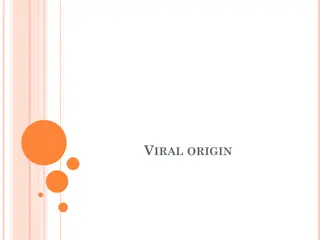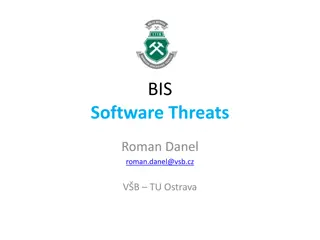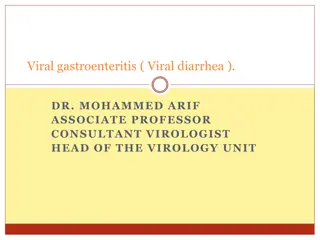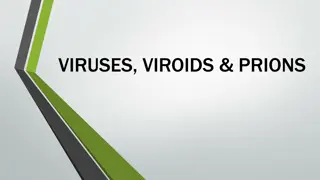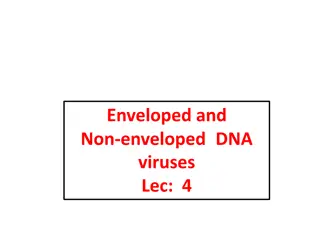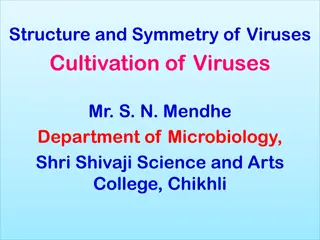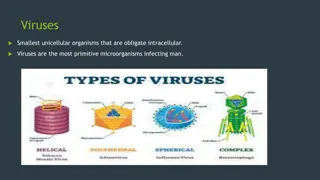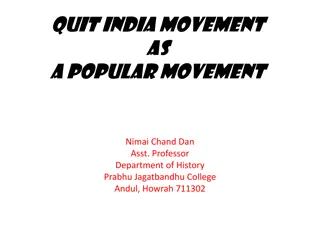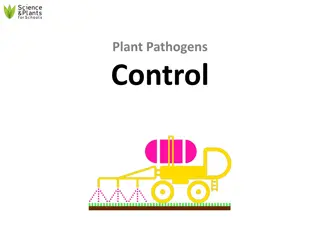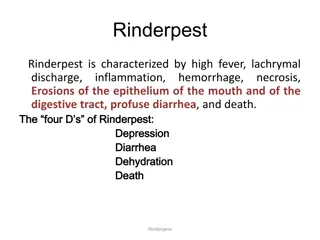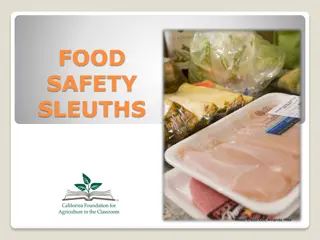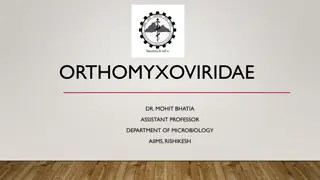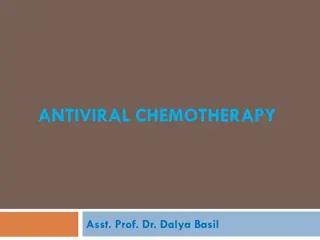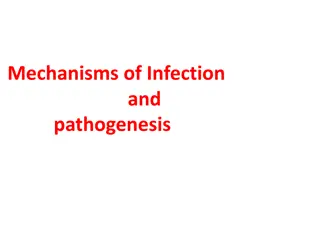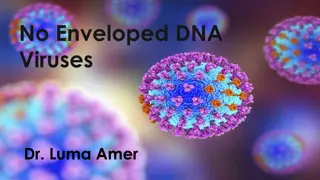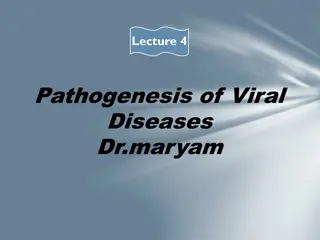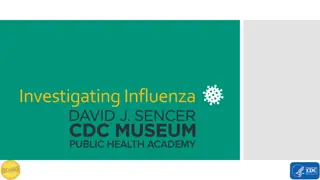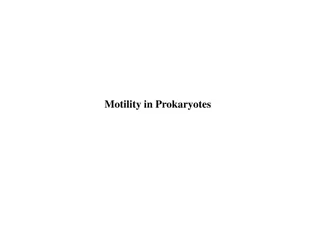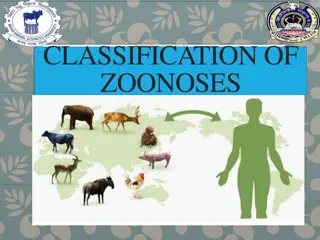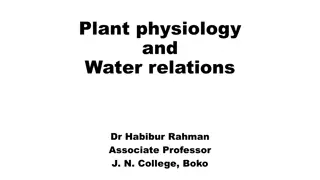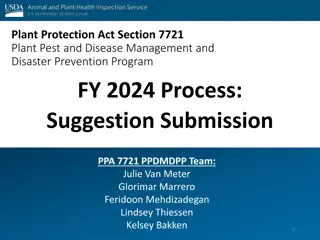The Transmission and Movement of Plant Viruses
Plant viruses are transmitted through various means such as cell-to-cell movement via plasmodesmata and systemic spread through vascular tissues. The viral proteins and mechanisms facilitating these movements are crucial for viral infection and spread within plant hosts. Understanding the different modes of transmission helps in managing viral diseases in plants effectively.
Download Presentation

Please find below an Image/Link to download the presentation.
The content on the website is provided AS IS for your information and personal use only. It may not be sold, licensed, or shared on other websites without obtaining consent from the author. Download presentation by click this link. If you encounter any issues during the download, it is possible that the publisher has removed the file from their server.
E N D
Presentation Transcript
TRANSMISSION OF PLANT VIRUSES
Cell-to-Cell Movement of Plant Viruses Plant viruses move cell-to-cell slowly through plasmodesmata Most plant viruses move cell-to-cell as complexes of non-structuralprotein and genomic RNA The viral protein that facilitates movement is called the movementprotein (MP) Coat protein is often dispensable for cell-to-cell movement
Cell-to-Cell Movement of Plant Viruses Several unrelated lineages of MP proteins have been described MPs act as host range determinants MP alone causes expansion of normally constricted plasmodesmata pores; MPs then traffic through rapidly MPs are homologs of proteins that naturally traffic mRNAs between cells MPs may act as suppressors of gene silencing
SOME PLANT VIRUSES RADICALLY MODIFY PLASMODESMATA, ALLOWING FOR CELL TO CELL MOVEMENT AS WHOLE PARTICLES.
Systemic spread of plant viruses is primarily through vascular tissue, especially phloem
Plant Virus Transmission Generally, viruses must enter plant through healable wounds - they do not enter through natural openings (no receptors) Insect vectors are most important means of natural spread Type of transmission or vector relationship determines epidemiology Seed transmission is relatively common, but specific for virus and plant
TYPES OF PLANT VIRUS TRANSMISSION HORIZONTAL TRANSMISSION Horizontal transmission is by vectors, human pruning shears and tools, and other direct, external contamination. VERTICAL TRANSMISSION Vertical transmission occurs when a plant gets it from its parent plant. Either through asexual propagation (cuttings) or in sexual reproduction via infected seeds.
TRANSMISSION METHODS Non-Insect transmission: Sap inoculation/ Mechanical: TMV, PVY Seed: BCMV, Fungi: Olpidium brassicae- TNV Vegetative & graft transmission: PVY, PLRV, Fruit viruses Nematodes: Xiphinema index: Grapevine fan leaf virus Dodder: CMV,TRV Insect Transmission: PVY, CMV, BGMV Insect Transmission: PVY, CMV,BGMV
Mechanical transmission o Deliberate rub-inoculation o Field farm tools, etc. o Greenhouse cutting tools, plant handling o Some viruses transmitted only by mechanical means, others cannot be transmitted mechanically o Occurs when plant come in contact with other plant andleaves rub together By the action of humans Mechanical transmission involves the introduction of infective virus or biologically active virus into a suitable site in the living cells through wounds or abrasions in the plant surface This method is generally used for experimental purposes under laboratory conditions- also known as Sap inoculation
METHODS Leaf rub Cotton swab Pinprick Microinjection Steps: Sap extraction Extraction medium Use of additives Choice of suitable host: most common are Nicotiana spp., Chenopodium spp., Cucumis sativus, Gomphrena, Datura spp, Phaseolus vulgaris
MECHANICAL TRANSMISSION AFFECTED BY: Symptoms expression Virus concentration Extraction medium (Water & Buffer) Buffers (Po4 , borate, citrate, Tris-HCL) Retain infectivity Stability Intact virus Avoidaggregation Buffer pH: 7-8 pH Source & preparation of Inoculum Leaf- most common source Have high conc of virus Roots: TNV Fruits, flower & pollens
Metal ions and ionic strength Some viruses require divalent metal ions (Ca+ or Mg2+) for retention of infectivity and structural integrity pH, chelating agents and ionic strength help in virus stabilization in extracted sap. Chelating agents eg. EDTA Help in removal of host ribosomes; avoid virus aggregation;prevent oxidantion of polyphenols Reducing agents: ( Thioglycolic acid, Ascorbic acid, cysteinehydrichlooride sodium sulphite, 2-mercaptaethanol) These prevent oxidation of plant extract and preserve infectivity of thevirus
Substances protecting against phenolics: cysteine hydrichlooride, sodium sulphite: prevent action of phenol oxidases. PVP-polyvinyl pyrrolidine, PEG: reduces binding of virus with phenols Additives that removes plant protein and ribosomes Mg bentonite- reduces contamination of virus extract with nucleases and ribosomes (mainly !9s protein) Charcoal: adsorb host pigments Na EDTA @ 0.01M ph7.4 Enzymes: eg. Pectinase is used to degrade mucilage in sap of cocoa leaves priorto precipitation of CSSC, Trypsin -TuMv
VEGETATIVE AND GRAFT TRANSMISSION Aim is to establish organic union between the cut surfaces of tissues of two different hosts Shoot-Scion Root bearing portion - stock If either stock or scion is infected the virus usually moves to thehealthy portion and express symptoms A pre-requisite for successful graft transmission is the perfect union ofthe cambium layers of the stock and the scion. Eg. CTV, Apple mosaic virusetc.
DODDER TRANSMISSION Cuscuta spp.(Benett (1940) About 20 spp. C. campestris & C. subinclusa are common E.g. Phytoplasma Vegetative propagations Cuttings Tubers Corms etc. Bulbs
Plant Virus Transmission by Vectors TRANSMISSION BY VECTORS: GENERAL o Arthropods most important o Most by insects with sucking mouthparts Aphids most important, and most studied Leafhoppers next most important o Some by insects with biting mouthparts o Nematodes are important vectors o Fungi (protists) may transmit soilborne viruses o Life cycle of vector and virus/vector relationships determine virus epidemiology o A given virus species generally has only a single type ofvector
Insect transmission (vectors) o Aphids most important o Leafhoppers o Whiteflies o Thrips o Mealybugs o Beetles o Mites (Arachnidae) o Ants, grasshoppers, etc. mechanical o Bees, other pollinators pollen transmission
Kingdom: Fungi Phylum: Chytridiomycota Class: Chytridiomycetes Order: Incertae sedis Family: Olpidiaceae Genus: Olpidium
Kingdom: Rhizaria Phylum: Cercozoa Class: Plasmodiophorea Order: Plasmodiophorida Family: Plasmodiophoridae Genus: Polymyxa
Types of vector relationships Terms apply mainly, but not exclusively, to aphid transmission Non-persistent transmission ovirus acquired quickly, retained short period (hours), transmitted quickly o stylet-borne transmission ovirus acquired and transmitted during exploratory probes to epidermis
PERSISTENT TRANSMISSION o virus acquired slowly, retained long period (weeks), transmitted slowly o circulative or propagative transmission o virus acquired and transmitted during feeding probes to phloem Virus persist in their vector for >100 hrs and in some cases for whole life of vector Virus multiply and circulate in vector body Latent period is present Moulting has no effect of virus After virus uptake-- alimentary canal gut wall cirulate In the body fluid (Haemolymph) glands causing contamination of salive Also called as Circulative Circulative propagative Trans-ovarial transmission E.g. PLRV, RDV, PYDV,BYDV salivary transmission
CIRCULATIVE TRANSMISSION: (syn. persistent transmission) virus transmission characterized by a long period of acquisition of the virus by a vector (typically an insect), a latent period ofseveral hours before the vector is able to transmit the virus, and retention of the virus by the vector for a long period, usually several days; the virus circulates in the body of the vector (aphid vector feeding on a plant host showing the internal route of the viruses that cause barley yellow dwarf)
Semi-persistent transmission o virus acquired fairly quickly, retained moderate period (days), transmittedfairly quickly o virus acquired and transmittedduring exploratory probes Virus persist in its vector for 10-100 hrs. Acquired from phloem region with long feeding No latent period Do not circulate and multiply in its vector Infectivity lost in moulting Particles accumulate at special sites High vector specificity E.g. CTV, CaMV,BYV
EXAMPLE OF INSECT TRANSMISSION Myzus persicae: most efficient among all; transmit >100 viruses
CONCEPT OF HELPER VIRUS These are the viruses transmitted by aphid vectors under certain conditions A aphid transmit can transmit the virus only if the source plant is infected by second virus. So it is a dependent virus and second virus is referred as the helpervirus virus
WHITE FLY transmit rugose diseases causing mosaic to leaf distortions Bemisia tabaci Virus vector relationship moslty circulative; semi persistent to persistent Females efficient in transmission LP-few hrs. Phloem Virus not transmitted by sap TLCV, MYMV, ClCV,BYVMV, BGMV, SYMV
LEAF HOPPERS/ PLANT HOPPERS Semi & persistent transmission Propagative viruses Causes mainly yellows, leaf rolling Phloem cells Leafhopper: RDV: Nephotetix cincticeps Rice tungro: N. impicticeps Transovarial transmission: RDV Plant hopper: maize mosaic: Pergrinus maidis Tree hopper: Tomato pseudo curly top: Micrutalis malleifera Micrutalis malleifera, the treehopper vector of Tomato pseudo-curly top virus
Thrips: transmit viruses in the genus Tospovirus. Frankinella occidentalis
BEETLE TRANSMISSION Acq. Feeding : upto 24 hrs Persistent transmission Cowpea mosaic virus: Ceratomatrifurcata Turnip yellow mosaic: Phyllotreta sp.
NEMATODE TRANSISSION Nematodes as vectors of plant viruses initiated research in Nematology and Virology Hewittet al. (1958) Helped in understanding of the transmission and etiology of an important group of soil-borne plant virus diseases. Two single-stranded RNAvirus genera, Nepovirus (NEPO) and Tobravirus (TOBRA), have nematode vectors Nepoviruses: Comoviridae family Tobraviruses: family not yet assigned
TOBRAVIRUS Nepoviruses (Nematode- transmitted Polyhedralviruses) Nepoviruses are isometric (polyhedral) particles around 30 nm in diameter (1 nm=10-9 m, 1 m=10-6 m). The only known nematode vectors are in thegenera Xiphinema and Longidorus Tobraviruses (Tobacco Rattle viruses) have nematodevectors (Lamberti and Roca, 1987). Tobraviruses are straight tubular particles with two size ranges,180- 210 nm and 45-115 nm. Trichodorus and Paratrichodorus are vectors.
VECTOR SPECIFICITY 11 spp of Xiphinema transmit 13 NEPO viruses. 11 spp of Longidorus transmit 10 NEPO viruses 14 spp of Trichodorus transmit various strains of two TOBRA viruses: tobacco rattle and pea early browning. Lamberti (1987) suggests that since several Trichodorid spp. transmit the same virus, and that both viruses are transmitted by the same nematode, vector specificity is less developed in Trichodorids than in Longidorids. Trichodorids may retain the virus for up to a year. Acquisition time may be less than an hour toseveral days, depending on the feeding characteristics of the nematode
TRANSMISSION BY FUNGI Teakle 1960: TNV transmittedby fungus Olpidium brassicae Barley yellow mosaic virus: Transmitted by the plasmodiophorid fungus Polymyxa graminis (Kusaba et al., 1971; Adams, 1990a), which is an obligate root parasite. The virus is acquired when the plasmodia of the fungus are growing inside the barley root cells and it is transmitted within the zoospores or resting spores that it produces.
Polymyxa graminis: the vector of several cereal viruses including e.g. Bymovirus Benyvirus,, Furovirus, Pecluvirus and Pomovirus
BIMODAL TRANSMISSION While aphid transmit non-circulative viruses either in non-persistent or semi- persistent manner Few viruses have been known to be transmitted in both the manners This typical mode of transmission was first referred as bimodal transmission by Chalfant and Chapman (1962) in case of CaMV by M. persicae and B. brassicae.
SEED TRANSMISSION The embryo become infected bytwo routes Directly from mother plant By pollens Developing embryo can be infected before fertilization by the infection of the gametes or by direct invasion ofthe embryo after fertilization Virus moves through the testa of immature seed after fertilization and reach micropylar region for embryo infection to occur. Micropyle is in close contact with the base of embryonic suspensor that help in nutrient flow to embryo. Seed transmission occurs in two ways Externally seed borne due to external contamination of the seed with virus particles (TMV,PVX) Internally seed borne (BCMV, CMV, BYMV,ULCV) due to infection of the living tissues of the embryo. Virus may be found in different parts of the seed but generally in embryonic tissues
DISTRIBUTION The virus is distributed at random and can be found in different parts of seed Embryo; BCMV, CpMv,TRSV Endosperm: BSMV Seed coat: BCMV, TMV,TSWV


